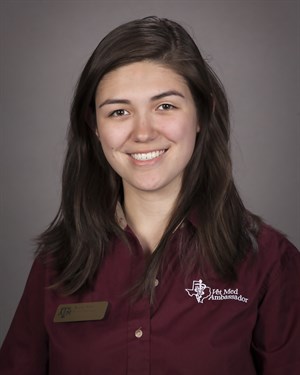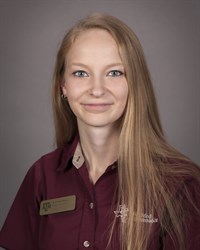
One of the many incredible things about veterinary medicine and Texas A&M is that not all learning happens in a classroom! Now that I’m in my third year of veterinary school, I have come to truly appreciate any opportunity to learn beyond sitting in a chair listening to lecture.
As ready as I am to hit the clinic floor come my fourth year in May, I am a little apprehensive to find out exactly how much I have learned. I am thankfully reassured every time I get the chance to exercise my knowledge.
My pet Labrador Retriever, Paisley, also gets to participate from time to time. In exchange for staying still enough for me and my groupmates to practice casting her leg or running an ultrasound, Paisley gets more treats and attention than she could ever ask for. As almost any Lab would, she loves it!
Not every day can be “Bring Your Lab to Lab Day,” though. Thankfully, we have models that also serve as great learning tools.
 Recently, in Orthopedic Surgery, we practiced fixing fractures on synthetic plastic bones. Although they weren’t exactly like the real thing, it was good practice trying to align the bone and drive a pin through it to stabilize it.
Recently, in Orthopedic Surgery, we practiced fixing fractures on synthetic plastic bones. Although they weren’t exactly like the real thing, it was good practice trying to align the bone and drive a pin through it to stabilize it.
By the end of the lab, I really got to admire how good I had gotten at twisting my wire tight.
I was surprised to find that something I never would have considered doing in normal practice two years ago—fixing a fracture with pins and wires—seemed totally feasible in the next year or two. What I had considered as a “specialty” procedure before, I now consider doing in the future if my patients need it all because I’m more comfortable performing it now.
It’s amazing how much a single lab can change your viewpoint!
One of my favorite hands-on opportunities is one that isn’t even specific to the veterinary college. Disaster Day is an annual disaster simulation that nursing, medicine, public health, and veterinary students all get to participate in.
I had opted not to participate in my previous two years of vet school and having finally taken the chance to try it out, I thoroughly regret not participating sooner!
 Though the event is a simulation that utilizes actors, it was surprising how much I immersed myself in the moment and learned from working through the various cases that were presented. The actors were so convincing and would show up anywhere from calm and collected to crying to screaming in panic!
Though the event is a simulation that utilizes actors, it was surprising how much I immersed myself in the moment and learned from working through the various cases that were presented. The actors were so convincing and would show up anywhere from calm and collected to crying to screaming in panic!
What was truly engaging and eye-opening to me was seeing the crossover between the veterinary and human medical fields as zoonotic diseases—diseases passed from animals to people—popped up over the course of the day. After the event, I found myself wrapped up in just replaying some of the day’s excitement over and over again in my head.
Just when I start to really grow tired of all those hours studying, some exciting opportunity pops up for me to practice what I’ve learned.
I’m three years in now and I can confidently say vet school is just exciting as it was on day one—if not more! Here’s looking to fourth year and all the exciting cases ahead of me.

 The veterinary school curriculum is designed to teach you many things. Yes, you will learn plenty of anatomy, physiology, and pathology, but there are some things that aren’t part of the curriculum that vet school teaches you, as well.
The veterinary school curriculum is designed to teach you many things. Yes, you will learn plenty of anatomy, physiology, and pathology, but there are some things that aren’t part of the curriculum that vet school teaches you, as well. Nine years ago, I informed my boss that I was leaving the company where I had been working for 12 years to pursue a career in veterinary medicine. The only thing I had at that point was a serious commitment to start this journey.
Nine years ago, I informed my boss that I was leaving the company where I had been working for 12 years to pursue a career in veterinary medicine. The only thing I had at that point was a serious commitment to start this journey. I’ve just started my last semester in the traditional veterinary classroom curriculum. It’s honestly a little weird to think that by this time next year I will have been in a hospital setting for more than half a year and will be just months away from being able to call myself “doctor.”
I’ve just started my last semester in the traditional veterinary classroom curriculum. It’s honestly a little weird to think that by this time next year I will have been in a hospital setting for more than half a year and will be just months away from being able to call myself “doctor.”
 I have recently been tasked with submitting my fourth-year rotation preferences for our next, and last, year. I cannot believe how quickly the time has passed. I was so overwhelmed when the administration first introduced this process to us.
I have recently been tasked with submitting my fourth-year rotation preferences for our next, and last, year. I cannot believe how quickly the time has passed. I was so overwhelmed when the administration first introduced this process to us. One of the most highly anticipated days for a veterinary student is the day you do your first spay or neuter in third year. That day is almost here for me!
One of the most highly anticipated days for a veterinary student is the day you do your first spay or neuter in third year. That day is almost here for me! My experience in veterinary school so far has been an exhilarating, eye-opening, challenging journey. While I’ve had its extreme highs and lows, I can honestly say that I have enjoyed the ride.
My experience in veterinary school so far has been an exhilarating, eye-opening, challenging journey. While I’ve had its extreme highs and lows, I can honestly say that I have enjoyed the ride.